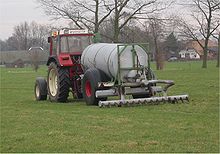Digester gas
Digester gas , also called swamp gas , sewer gas or sewage gas depending on its occurrence , is a mixture of mostly flammable gases that is created during anaerobic fermentation . Biotic substances are decomposed by bacteria and archaea in the absence of oxygen , which is typical for putrefaction processes (hence the name digester gas). Methane with the empirical formula CH 4 has the largest share of the combustible components of the gas mixture .
ingredients
Besides other gases, the unpleasant odor of the digester gas is mainly caused by hydrogen sulfide (dihydrogen sulfide, empirical formula: H 2 S), which smells like rotten eggs and is released in the ppm range during fermentation . The decisive factor for this is the sulfur concentration of the starting material, which results from the proportion of proteins present.
The digester gas produced in sewage treatment plants ( sewage treatment plants ) in digestion towers often has higher proportions of hydrogen sulfide. If no iron (II) ions are used for binding there, the H 2 S concentration can rise to over 2500 ppm. If the digester gas, like biogas, is used to generate electricity with gas engines , values above 200 ppm are disadvantageous. It is possible to clean the digester gas from hydrogen sulfide.
In addition to the methane already mentioned above, digester gas also contains oxygen (O 2 ), carbon dioxide (CO 2 ), carbon monoxide (CO) and ammonia (NH 3 )
Emergence
In nature, digester gas arises in swamps and other stagnant bodies of water in the absence of oxygen, since oxygen is a deadly poison for the anaerobic methane-forming agents (archaea). Because of this formation, it is also called swamp gas . Digestion gases are possibly one of the causes of will- o'-the-wisps .
However, digester gas is not only generated in water bodies, but also in the intestines of humans ( flatulence ) and animals as well as in the rumen of ruminants (a prominent example are cattle ) by archaea, as these often play an important role in digestion .
Since the main component of digester gas is methane, which is partly responsible for the greenhouse effect , extensive studies have been carried out on the contribution made by agriculture . The result was that rice fields , cattle and manure are the main sources of anthropogenic methane.
In sewers
The fermentation gas produced in sewer systems is also called sewer gas . It can be a hazard when performing sewer works .
To prevent accidents, for example, gas warning devices can be used that warn the wearer when certain concentrations of potentially toxic or asphyxiating gases are reached. The use of multi-gas measuring devices is ideal here.
Technical use
In technical facilities, digester gas is generated when the sewage sludge rots out , which is produced during wastewater treatment in sewage treatment plants ( sewage gas ). Sewage gas has been used in engines to generate electricity since the 1950s. In waste dumps and in biogas plants (hence the names landfill gas or biogas ), digester gas is also produced in the same way.
The fermentation of biotic substances in sewage treatment plants, landfills and biogas plants and the subsequent use of the gas is economically and ecologically interesting:
- Methane is also the main component of natural gas and a valuable fuel .
- The gases methane and nitrous oxide , which are produced when nitrogenous biological substances such as liquid manure are broken down, do not escape into the environment when the digester gases are burned .
- The remains of the digestion (for example the remains of sewage sludge) are much less problematic for soil and water than the original waste (for example overfertilization by nitrate , a breakdown product of the ammonium contained in agricultural waste such as liquid manure ).
Web links
- Article onarbeitssicherheit.de (Retrieved February 8, 2016)
Individual evidence
- ↑ Duden | Sewer gas | Spelling, meaning, definition. In: www.duden.de. Retrieved February 8, 2016 .
- ↑ Usemann, Klaus W .: Building technology: Lexicon of terms . Oldenbourg-Industrieverlag, Munich 2001, ISBN 978-3-8356-6395-4 , p. 266 .



